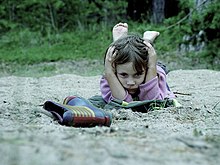Our website is made possible by displaying online advertisements to our visitors.
Please consider supporting us by disabling your ad blocker.
Disruptive mood dysregulation disorder
| Disruptive mood dysregulation disorder | |
|---|---|
 | |
| Children with DMDD show persistent irritability with angry temper outbursts. | |
| Specialty | Psychiatry, clinical psychology |
| Usual onset | Ages 6 to 10 |
| Duration | At least one year, often resolves by adulthood |
| Risk factors | Temperament, environment, genetics |
| Differential diagnosis | Bipolar disorder, major depressive disorder, anxiety disorder, oppositional defiant disorder, attention deficit hyperactivity disorder, autism spectrum disorder, intermittent explosive disorder, conduct disorder |
| Treatment | Medication, therapy |
| Medication | Stimulants (associated symptoms), antidepressants, antipsychotics |
Disruptive mood dysregulation disorder (DMDD) is a mental disorder in children and adolescents characterized by a persistently irritable or angry mood and frequent temper outbursts that are disproportionate to the situation and significantly more severe than the typical reaction of same-aged peers. DMDD was added to the Diagnostic and Statistical Manual of Mental Disorders, Fifth Edition (DSM-5) as a type of mood disorder diagnosis for youths.[1][2] The symptoms of DMDD resemble many other disorders, thus a differential includes attention deficit hyperactivity disorder (ADHD), oppositional defiant disorder (ODD), anxiety disorders, childhood bipolar disorder, intermittent explosive disorder (IED), major depressive disorder (MDD), and conduct disorder.[3][4][5]
DMDD first appeared as a disorder in the DSM-5 in 2013[6] and is classified as a mood disorder.[3] Researchers at the National Institute of Mental Health (NIMH) developed the DMDD diagnosis to more accurately diagnose youth who may have been previously diagnosed with pediatric bipolar disorder who had not experienced episodes of mania or hypomania.[7]
Diagnosis requires meeting criteria set by the DSM-5, which includes frequent and severe temper outbursts several times a week for over a year that are observed in multiple settings.[3] Treatments include medication to manage mood symptoms as well as individual and family therapy to address emotional regulation skills.[4] Children with DMDD are at risk for developing depression and anxiety later in life.[3][6]
- ^ "A Guide to DSM-5: Disruptive Mood Dysregulation Disorder (DMDD)". medscape.com. 2013-05-21. Retrieved 2024-01-16.
- ^ "Highlights of Changes from DSM-IV-TR to DSM-5" (PDF). psychiatry.org. American Psychiatric Association. Archived from the original (PDF) on 2013-02-03.
- ^ a b c d Diagnostic and statistical manual of mental disorders (5th ed.). Washington, DC: American Psychiatric Association. 2013-05-22. ISBN 9780890425541.
- ^ a b Cite error: The named reference
:7was invoked but never defined (see the help page). - ^ Cite error: The named reference
:3was invoked but never defined (see the help page). - ^ a b Weis R (2014). Introduction to abnormal child and adolescent psychology (2nd ed.). Los Angeles: SAGE. p. 477. ISBN 9781452225258.
- ^ "Disruptive Mood Dysregulation Disorder: The Basics". National Institute of Mental Health (NIMH). Retrieved 2024-01-16.
Previous Page Next Page


